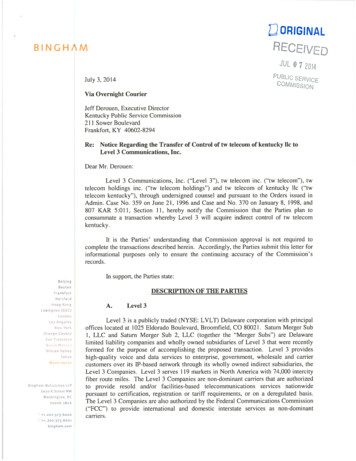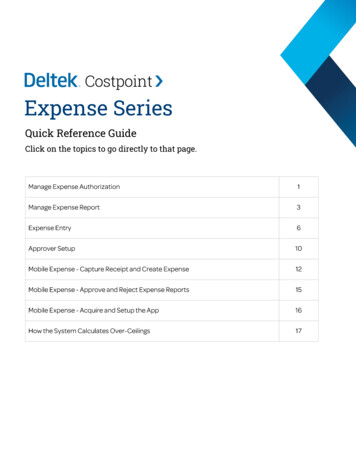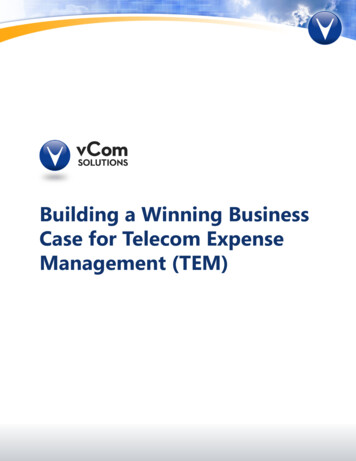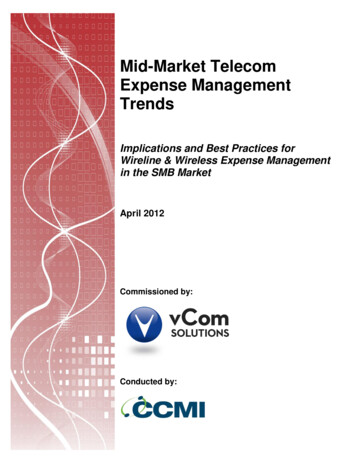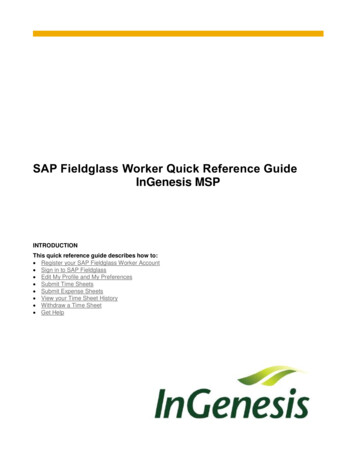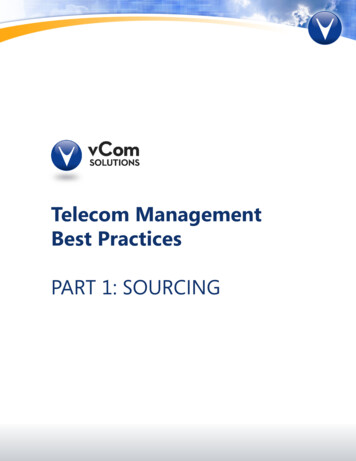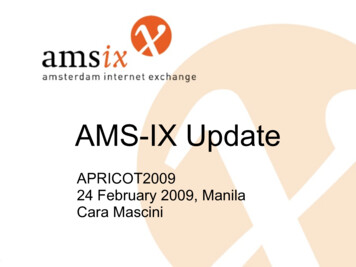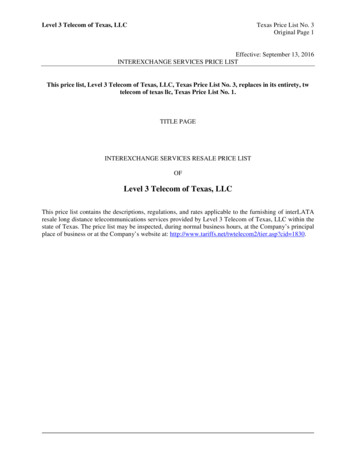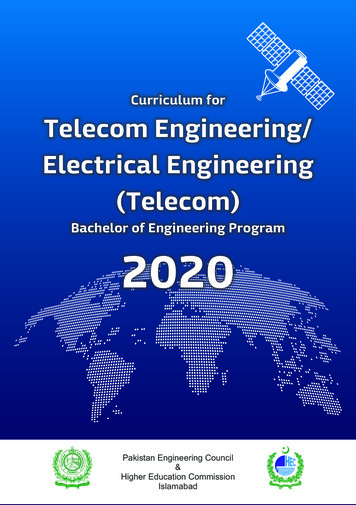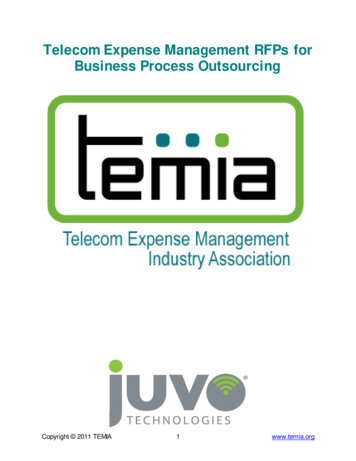
Transcription
Telecom Expense Management RFPs forBusiness Process OutsourcingCopyright 2011 TEMIA1www.temia.org
Executive SummaryThis paper addresses how to develop and manage a Request for Proposal (RFP) for aBusiness Process Outsource (BPO) for Telecom Expense Management. The TelecomExpense Management Industry Association, (TEMIA) is publishing this information tohelp educate the market and reduce the time for organizations to buy a TEM solution.Good RFPs enable businesses and government agencies to evaluate competingproposals in an efficient and fair manner. TEMIA’s goal is to streamline the RFP processby ensuring that RFPs contain information that enable evaluation teams to select thebest supplier for their needs, while avoiding common mistakes that come from usingRFP templates and standard language that fails to address customization required forTEM programs.Caution before ProceedingRFPs are not always the best approach to buying a TEM solution. Smaller companiesshould work to avoid overloading themselves with RFPs that contain too much materialto evaluate. Also, the RFP process can create barriers between customers and potentialsolution providers. These barriers can block the flow of information preventing solutionproviders from responding to customer challenges and evaluation teams from makinggood decisions. Focusing too much on getting the lowest price can cost more over timesince the fees for a TEM solution are a small fraction of the savings that an effectiveTEM program will produce.TEMIA has authored this paper. TEMIA’s mission is to raise awareness and knowledgeof the benefits of TEM solutions, to improve the quality and value of TEM solutionsthrough the development and promotion of open industry standards, and to cultivateshared industry knowledge among TEM providers, business partners, telecom serviceproviders, and enterprise clients. TEMIA is a nonprofit association, which receives itsfunding primarily from TEM and WEM Solution Providers.How to Use This GuidePlease do not skip the first sections of this document. Learning about TEM, assessingyour business needs, and goals are critical steps. Starting with these steps will avoidmissteps and delays. It will also help streamline evaluation of RFPs and selection of aTEM Solution Provider.This document also contains information to help justify TEM programs and establish abaseline to project benefits of a program. The RFP section will require tailoring ofquestions and omitting some items to meet the needs and circumstances of yourcompany. TEMIA welcomes the opportunity to receive feedback as you work through theRFP process and select the best TEM Solution Provider for your needs.Copyright 2011 TEMIA1www.temia.org
Table of ContentsExecutive Summary . 1Chapter One: Learn About TEM . 1Chapter Two: Assess Business Needs and Goals . 5Chapter Three: Statement of Work and Cost Justification . 10Chapter Four: The RFP for TEM BPO/Managed Services . 13Request for Proposal: Telecom Expense Management . 14Chapter Five: Conclusion . 28About TEMIA .Error! Bookmark not defined.About Cynergy Services 29Figures & TablesFigure 1: TEM Components . 1Table I: Buyers Checklist TEM/WEM. 13Copyright 2011 TEMIA1www.temia.org
Chapter One: Learn About TEMWhether managers are evaluating a single TEM Solution Provider or issuing aformal RFP, they should approach the selection process in the following stages:1.2.3.4.5.6.Learn about TEMAssess business needs and goalsCreate a Statement of Work and clearly define what you will be buyingDevelop a cost justification for TEMEvaluate solutions and service level agreementsMake a decisionI. Learn About TEMTEM engagements vary considerably from one client to the next, and solutionproviders are not all the same. One challenge for organizations that areevaluating TEM is the lack of standards for TEM solutions. Early in the process, itis critical for managers to determine what they are buying. This will enable themto communicate their needs and make effective comparisons of capabilities. Italso streamlines the buying process.An effective TEM program manages the full lifecycle of a telecom expense. Itfocuses on eight major service domains, which include inventory managementand change control, sourcing, procurement and fulfillment, invoice management,expense management (including validation and optimization), usage chargeback,bill payment, and reporting.Figure 1: TEM ComponentsFixedThesestandards andKPIs have adirect link toTEM value,ROI, and SLAs.MobileInternationalBusiness IntelligenceInventory Management & Change ControlSourcingProcurement & FulfillmentInvoice ManagementExpense ManagementUsage ChargebackPaymentReportingCopyright 2011 TEMIA1www.temia.org
Inventory Management and Change ControlA TEM inventory consists of inventory elements, which are any item thatappears on a bill or customer service record (CSR) for a line, circuit, mobileline, or service provided by a telecom service provider. This is different from acomprehensive inventory, which includes items that do not appear on bills.Some TEM Solutions Providers will go a step further adding telecom assetsthat do not appear on carrier bills. This could include mobile accessories,mobile software licenses, routers, network hardware and other customerpremise equipment (CPE). Equipment, especially the maintenance on CPEfor a managed services network, will have invoices from Cisco, Avaya, andother managed network service providers with opportunities for assetmanagement, sourcing, validation, optimization, cost allocation, budgetingand reporting. There may also be opportunities to manage maintenancecharges or find value in redeploying it when employees leave or sites areclosed. Since carriers do not usually sell them, these items are usually not onCSRs,. For enterprises that seek complete management of all telecom andnetwork assets, it is important to understand how the information will becaptured and who will be responsible for: verification of its accuracy, its entryinto the database and ongoing cost management functions.In addition, most international service providers do not use CSRs, and CSRsdo capture information regarding wireless devices and mobile services.Wireless inventories require additional information for optimization and otherWireless Expense Management (WEM) functions. Inventory for mobiledevices should include: Employee name or identification numberEmployee Status (active or no longer working for firm)Job role/function, department, general ledger code and cost centerEmployee location, region and countryMobile phone numberMobile Service ProviderPlan activation and contract expiration dateDevice model numberInternational Mobile Equipment Identity (IMEI number)Eligibility date for new hardware that is subsidized or freeServices: voice, texting, data, international useHow the bill is paid (direct by company, reimbursement, stipend)Sourcing and expense management use inventory for optimization, billvalidation, and usage charge-back. Change control refers to the tracking,management and control of Move Add Change and Disconnect (MACD)activity. Tracking the MACD activity is critical because the inventory is amoving target. Bills may contain disconnected items so enterprises mustreconcile inventory with invoices to ensure billing accuracy.Copyright 2011 TEMIA2www.temia.org
SourcingSourcing includes negotiation of contract rates, special pricing, terms andconditions. A TEM solution should provide monitoring of contractperformance, and proactive notice of contract expirations at preset intervals.An important precondition for sourcing of telecom services is establishingconditions in which telecom service providers will compete on pricing, servicequality and reliability. Procurement and FulfillmentProcurement and fulfillment enables enterprises to enter orders, manageworkflow for approval of orders, and placement of orders with carriers througha portal or service. Fulfillment of orders includes tracking order milestonesand escalation if promised delivery dates are missed. Invoice ManagementInvoice Management consists of a process to receive all invoices. It shouldinclude conversion of paper billing to electronic media and software tocentralize processing and management of bills. Carrier billing is highlycomplex with a wide range of services, special features and line items. A lackof standards for Telecom Service Provider billing formats makes it difficult fororganizations to process bills in electronic format without custom software.Automation and conversion of bills to electronic media reduces the costs ofmanually processing paper bills, avoids data entry errors and streamlines thetime to process bills. Expense Management (Audit and Optimization)Expense management includes validation of expenses and optimization ofcharges. Bill validation should include reconciliation to contracts, tariffs, andinventory. MACD activity must be reconciled with billing. This step includesidentification of billing errors and overcharges, documentation and filing ofclaims with Telecom Service Providers.Optimization of enterprises’ communications infrastructure and networkexpenses provide savings through cost avoidance. Savings come fromreconciliation of usage and services with reduction from unused orunderutilized lines and services; identification of services that do not have acontract or those that have uncompetitive contracts; finding inactive lines andcircuits; analysis of equipment leases; and grooming of services to highercapacity lower cost services. Usage ChargebackTEM programs promote accountability for the service consumption andvisibility through expense chargeback. The level of detail for chargeback caninclude call detail tracking.Copyright 2011 TEMIA3www.temia.org
PaymentA number of TEM Solution Providers refer to the step of batching andsubmission of bills to the customer as payment when the customer is actuallymaking the payment to the service provider. In other cases, the supplier isactually referring to paying the bills on behalf of its customers. In this case,the TEM Solution Provider establishes an account for the customer totransfer funds and pay Telecom Service Providers.Regardless of which approach is selected, the program should also include afeed that allows for tracking the invoice payment date, the amount that waspaid, the name of the Service Provider, the address or account that receivedthe funds, and when the funds cleared. ReportingReporting provides detailed information on telecom expenses and budgets.The data should be available in a usable format that is readily accessible tomanagers. Effective reporting will help provide dashboard information in agraphical format with trending for expenses.Fixed, Mobile and InternationalEnterprises need to determine if the TEM project will include domesticwireline, wireless, and/or international expenses. With Wireless ExpenseManagement, enterprises must balance expense management withexpectations of employees for mobile services that will help make them moreproductive and help desk support. Multi-national enterprises may seek toexpand the program to manage international telecom expenses.The three areas of fixed, mobile and international telecom expenses have anumber of unique challenges. Telecom Service Providers use different billingsystems because regulations and revenue models vary for each of theseservices. Enterprises may also have different groups that manage these threeareas. The sample RFP addresses these challenges and differences.Copyright 2011 TEMIA4www.temia.org
Chapter Two: Assess Business Needs and GoalsII.TEM Needs AnalysisBefore selecting a solution provider or issuing an RFP, organizations should usethe “Needs Analysis” questionnaire, to gather information and data that it will useto establish a baseline for its current program. TEM Solution Providers can assistduring this analysis phase by offering guidance on how to collect the informationor even gathering this information for larger projects.TEM Needs AnalysisA. How does the company manage its telecom services inventory?1) Is there an accurate, up-to-date inventory of telecom services?2) Is the inventory in spreadsheets or is it in a database?3) When there are Moves Adds, Changes and Disconnect (MACD)procurement orders, is there a manual or automated process to updatethe inventory?4) What level of detail does the inventory have? (Does the inventory refer toeverything as a circuit or does it contain more specific information like thetype of service/circuit private lines, frame relay, ATM, MPLS?)5) Is there a common process to manage inventory or do offices, regions, orcorporate divisions have different approaches to managing inventory?6) Does each group use common software to manage inventory?7) Each month, is software used or do personnel manually reconcile billswith inventory?B. How does your company manage sourcing?1) Does a dedicated team manage all sourcing activity?2) Does your company secure competitive bids for all services including longdistance, fixed data, local, wireless, and international?3) Does the process include formal RFPs?4) When negotiating new telecom contracts, what benchmarks are used tocompare rates?5) Does your firm negotiate the terms and conditions in telecom contracts?6) Is there software or personnel that track expiration dates and updates totelecom contracts from carrier’s addendums and other online updates?7) Does the system automatically notify managers before contracts expire?8) Is there software or do personnel monitor Minimum Annual RevenueCommitments (MARCs) for each contract?Copyright 2011 TEMIA5www.temia.org
C. How does your company manage procurement of new services?1) What is the current volume of MACD items each month?2) What reporting and tracking does the company have for monitoringMACD activity?3) What changes in MACD volume will occur over the next 12 months?(Are there any plans for site moves, acquisition of other companies,divestures, transitioning of network services from carriers or newservices i.e. MPLs, VoIP, etc.)?4) Is there a common process to manage MACD activity or do offices,regions, or corporate divisions have different methods to manage andtrack this activity?5) Does the enterprise have a portal to manage MACD activity?6) How is reconciliation of MACD activity with billing performed eachmonth? (Is there automation with software or is it a manual process?)7) Are there plans to change how MACD activity is managed?D. How are telecom invoices managed?1) Do offices, regions, or corporate divisions have different approaches toprocessing bills?2) On average, how many days does it take to process and pay an invoice?3) What are the costs and procedures for archiving telecom invoices?4) What procedures identify lost and missing telecom bills?5) What service providers, products, expenditures, number of billing accountnumbers (BANs) are processed each month? Please use the chart belowto gather this information listing and each country separately.CountryService ProviderCopyright 2011 TEMIAProduct TypeMonthlySpend ( )6# ofBAN’s# of SummaryBAN’sEDIFormat of BillsPaperWebCDwww.temia.org
E. How are telecom expenses managed? (Validation and Optimization)1) Are all bills validated each month and claims submitted for billingerrors?2) Is there an internal team that performs this work or an outside firm?3) What claims were submitted over the past two years and what werethe actual refunds for the billing claims?4) Please use the table below to identify optimization savings over thepast two years for each category.Savings CategoryDisconnecting unused or underutilized lines andservices and ensuring they are removed from billingWireless service optimization through analysis ofemployee consumption to ensure that employees havethe best plans based on their monthly usage. (Employeesmay be forfeiting unused minutes or not consumingenough data to justify the additional expense of extraminutes or an unlimited data plan. Alternatively,employee’s accounts may incur overage charges.Switching employees to a more appropriate plan based ontheir usage will reduce future expenses.)Identification of services that do not have contractsand securing a lower cost contract for the servicesGrooming of services to higher capacity lower costservices (The price of a T3 line is more competitive thansix or eight T1 lines,. A T3 line is equivalent to 28 T1 lines.Grooming or replacing a number of T1 lines with a T3reduces costs.)SavingsF. How do you manage usage allocation chargeback?1) Are telecom expenses allocated based on actual usage using callaccounting and monitoring of call activity through the PBX or call detailfrom EDI bills or is there a different approach to expense allocations?2) What is the current level of detail for expense allocation: Invoice, circuit, Universal Service Ordering Code (USOC), other? Individual, department, region, business unit?3) Who has access to reports on telecom spending, and what items are inthe reports?4) Does the current system capitalize installation charges?5) Are taxes and surcharges broken out separate from monthly servicefees?6) What is the average number of allocations per Billing Account Number?7) How often do expense allocation schemes for departments, regions, andbusiness units change?Copyright 2011 TEMIA7www.temia.org
G. How is bill payment for telecom invoices performed?1) How many people handle an invoice from receipt to payment?2) Is there a way to monitor each step: who has the invoice, and whether ithas been approved for payment, paid, and receipt of payments?3) Over the past twelve months, was the cost for late payments penalties?4) Are journal entries manually entered or is there an automatic interface tothe Accounts Payable system?5) What accounting system does your company use?6) Do you require any form of fiduciary approval (manager sign-off based onexpense levels) of invoices before payment is made?H. Will the scope of work include international locations?1) Are there any international locations for telecom services? If not, skipto section I.2) Where are international telecommunications expenses managed?3) Do the processes for tracking and reporting of telecom expensescomply with local regulations including data privacy and protection,safe harbor and electronic billing?4) For reporting, payment and accounting, what common currency andlanguage(s) are used?5) Where will purchases of a TEM and WEM solution originate? Will it beby geographic region or will there be one central approach?I.Will the scope of work include wireless services?1) Does the company provide company-paid wireless devices? If not,skip to section J.2) How many company-paid wireless devices are there?3) Is there a formal policy for use of corporate wireless devices?4) Is there a consistent approval process to determine eligibility forcorporate paid wireless services?5) Is there a consistent process to deactivate devices and wipe datafrom devices?6) Does the company have a capability to replace devices within a preestablished time to ensure end-user productivity?7) Is there help desk support for wireless applications, and security?8) Does the system track voice minutes and data to monthly planallowances?9) Is there exception reporting for spending that does not comply withcorporate policy?J. Will call accounting be part of the program?1) Is there a system to track and identify long calls, calls to blockednumbers and suspicious call activity?2) Does the system track: usage by employee, most expensive calls,most lengthy calls, most dialed numbers, and call detail (call time,numbers)?3) Does the system track trunk utilization?4) Does the system track Quality of Services (QoS)5) Does the call accounting program comply with local regulationsincluding data protection and privacy?Copyright 2011 TEMIA8www.temia.org
K. Have historical audits been performed?1) Have there been any previous telecom expense validation andoptimization work? If yes, when was it complete?2) What cost savings and refunds did these projects produce?Collecting the information for the TEM Needs Analysis questionnaire is hardwork. Organizations often want to move directly to an RFP template. This wouldbe a mistake. A baseline understanding of the current activities and processes tomanage telecom expenses is critical. As the information is collected, managersneed to ask themselves: What is the biggest challenge with the current process? What activities are missing from the current approach to telecomexpenses management? What value and savings would these activities provide?How many individuals are involved with managing the entire life cycle of atelecom expense and the following functions?Number of employees, orportion of employee’s timedoing this activityActivity Copyright 2011 TEMIASourcingUpdating and managing telecominventoryReceiving billsPursuing missing billsValidating bills for accuracy againstcontracts and other special pricingValidating bills for accuracy of taxesReconciling bills with MACD inventoryactivitySubmitting and pursuing claims withservice providersManaging usage expense chargebacksPaying billsGenerating reports and analyzingspending trends9www.temia.org
Chapter Three: Statement of Work and Cost JustificationCreating a Statement of WorkThe questions in “Needs Analysis” identify areas for improvement and goals forthe TEM program. This will help define what you need, ensure that the solutionfits your specific needs and help to avoid a program that is too small or too large.A Statement of Work captures and defines TEM activities, deliverables and thetimeline that a TEM Solution Provider will execute for a client. It is part of therequest for proposal and may also be used for a Service Level Agreement (SLA).The TEM Needs Analysis should be included in the Statement of Work. It shouldexplain why the organization is seeking to procure a TEM solution and describethe work in detail. (More follows in the TEM RFP)Executive SponsorshipAn organization must obtain internal consensus and alignment on the areas forimprovement before creating a Statement of Work. Developing an internalconsensus should include getting executive sponsorship for the TEM program.On average, enterprises spend between two and four percent of corporaterevenue on telecom services for the voice and data network. Telecom expensesare one of their top five line-item expenses in the budget. With this high level ofexpenditures, it would seem natural for C-level executives to play a roleoverseeing TEM programs.Telecom expenses have attractive opportunities for cost control and optimization,yet many organizations indicate that executives do not play a role with TEMprograms. This is unfortunate, because the most successful engagements haveC-level involvement. Lack of technical knowledge may explain Chief FinancialOfficers’ reluctance to get involved with TEM, and Chief Information Officersoften delegate TEM to other members of their team.CFOs and CIOs do not need to get involved in every detail of implementing aTEM program and management of the program. Below are areas where CFOsand CIOs can affect the success of a TEM program.CFOs Role Serve as a catalyst and establish an agenda for cost cutting Set corporate standards and drive accountability for expenses Establish rules for recognition and reporting of savingsCIOs Role Drive adoption of TEM applications across different departments Ensure system integration of TEM with enterprise resource planning andfinancial enterprise applications Eliminate duplication of efforts that result from employees continuing toenter data in legacy systems Drive standardization to one application for managing and reporting oftelecom expensesCopyright 2011 TEMIA10www.temia.org
TEM Cost JustificationIn addition to the TEM Needs Analysis, an effective cost justification for TEM willhelp to avoid buying a solution that exceed the needs of the organization orbuying a solution that fails to meet its the needs.Savings from TEM programs fall into three main categories: Spending less on telecom services Labor efficiencies Indirect savingsSavings CategoryPotential SavingsSpending less on telecom servicesA. Recovery of refunds for billing errors1) Audit and recovery of billing overcharges2% - 15%2) MACD reconciliation and recovery of billing overchargesof expensesB. Cost avoidance by reducing future spending1) Strategic Sourcing: better contracts and rates5%-25%2) Inventory managementa) Grooming to higher capacity lower cost servicesb) Elimination of unused services3) Optimization5%- 15% ofexpensesa) Wireless service optimizations of voice and data matchingconsumption to service plansb) Identification of services with no contracts, receiving betterrates though quote requests and negotiationc) MARC penalty avoidanceDepends on MARCs4) Accountability chargeback visibility, reporting on usage1%-3% of expenses5) Elimination of late payment penalties and service disruption.5-2% of expensesfor late payments, nonpayment, or lost billssubject to penaltiesLabor efficiencies automating manual processes or outsourcingA. Automating procurement processesFTE reallocation or FTEcost – BPO costB. Automating inventory managementFTE reallocationC. Consolidation of invoices to reduce the volume of paymentsFTE reallocationD. Automating invoice management and validationFTE reallocationE. Automating usage chargeback and reportingFTE reallocationF. Reducing help desk supportFTE reallocation or FTEcost – BPO costIndirect savingsA. Consistent application of procurement policies1%-5% of expensesB. Unifying processes and improving collaboration1%-3% of expensesC. Risk mitigation from improved compliance to mobile policyLikelihood of breach Xcost of lawsuit orpenaltiesD. Better information for improved decisionsbenefit from betterdecisionsE. Freeing working capitalcost of funds X savingsF. Redirecting staff to focus on income producing projects andincome or value fromareas where they add more valuenew activities orstaff cost“Priceless”G. Application of corporate business, mobile policy andaccounting rules globallyH. Compliance to each country’s regulations“Priceless”Copyright 2011 TEMIA11www.temia.org
In general, the likelihood that a TEM program will produce savings to justify itsexpenses depend on the complexity of the telecom contracts in the program, theamount of Move Add Change, and Disconnect (MACD) activity, the quality ofhistorical records, telecom services in the program, and some other factors.Ultimately, the cost justification should focus on areas that add value for theorganization. Cost avoidance savings are an important part of justifying a TEMprogram and evaluating its ongoing performance.Enterprises also need to align savings calculations from cost avoidancemeasures with their corporate policies and a practical approach. The CFO canhelp by establishing rules for recognition of savings and reporting of thosesavings. There are several different approaches for calculating savings: Savings for the budget year Savings for the calendar year Savings for the term of the contract Savings for a rolling 12-month termThe budget year or calendar year approach may create incentives to maximizethe savings calculations by timing receipt or recognition of savings to the start ofthe budget. Using a calendar year approach to calculating savings would meanthat a cost savings counts for just one month in December. In January the samecost savings issue will count for 12 months. A rolling 12 month term forcalculating savings avoids the issue of incentives that lead to “finding” savings inJanuary each year.It is also important to consider the cost of not acting or delayed action. Withtelecommunications expenses, there are costs for not acting because carriercontracts often limit the period of time in which customers can file claims forrefunds. The statue of limitations for refunds is typically 6 months for longdistance services and two years for local billing. Increasingly, telecom ServiceProvider Contracts are setting more stringent limits on the time to file a claim fora billing error.Copyright 2011 TEMIA12www.temia.org
Chapter Four: The RFP for TEM BPO/Managed ServicesAfter learning about TEM, assessing business needs, creating a Statement ofWork, and developing a cost justification for the TEM program, the next step isrefining a Statement of Work (SOW) by meeting with TEM solution providers.There are two critical objectives for these meetings. First, managers need toensure that the SOW reflects enough information to receive RFP responses thataddress the entire scope of work. A second critical objective is to narrow thenumber of solution providers that will receive the RFP. Competition is healthy,but too much competition is not good. Attempting to evaluate too many RFPresponses leaves less time to review each response and evaluate eachsupplier’s capabilities.The goal in selecting solution providers that will receive the RFP should be toinclude prospective firms that can meet your specific requirements and those thatwill provide a solid return for the program. It is also important to include only TEMSolution
This paper addresses how to develop and manage a Request for Proposal (RFP) for a Business Process Outsource(BPO) for Telecom ExpenseManagement. The Telecom Expense Management Industry Association, (TEMIA) is publishingthis informationto help educatethe market and reduce the time for organizations to buy a TEM solution.
